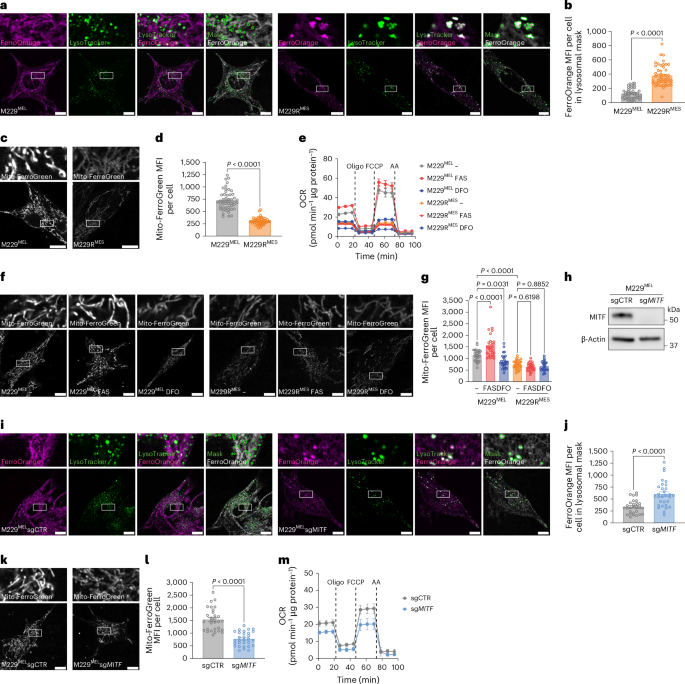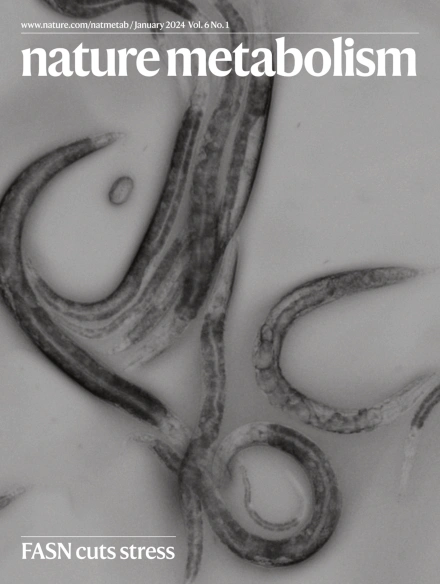BDH2-driven lysosome-to-mitochondria iron transfer shapes ferroptosis vulnerability of the melanoma cell states
IF 20.8
1区 医学
Q1 ENDOCRINOLOGY & METABOLISM
引用次数: 0
Abstract
Iron sustains cancer cell plasticity, yet it also sensitizes the mesenchymal, drug-tolerant phenotype to ferroptosis. This posits that iron compartmentalization must be tightly regulated. However, the molecular machinery governing organelle Fe(II) compartmentalization remains elusive. Here, we show that BDH2 is a key effector of inter-organelle Fe(II) redistribution and ferroptosis vulnerability during melanoma transition from a melanocytic (MEL) to a mesenchymal-like (MES) phenotype. In MEL cells, BDH2 localizes at the mitochondria–lysosome contacts (MLCs) to generate the siderophore 2,5-dihydroxybenzoic acid (2,5-DHBA), which ferries iron into the mitochondria. Fe(II) transfer by BDH2 supports mitochondrial bioenergetics, which is required to maintain lysosomal acidification and MLC formation. Loss of BDH2 alters lysosomal pH and MLC tethering dynamics, causing lysosomal iron sequestration, which primes MES cells for ferroptosis. Rescuing BDH2 expression, or supplementing 2,5-DHBA, rectifies lysosomal pH and MLCs, protecting MES cells from ferroptosis and enhancing their ability to metastasize. Thus, we unveil a BDH2-dependent mechanism that orchestrates inter-organelle Fe(II) transfer, linking metabolic regulation of lysosomal pH to the ferroptosis vulnerability of the mesenchymal, drug-tolerant cancer cells. Rizzollo et al. show that BDH2 participates in iron distribution between cellular compartments, which sets the threshold for the ferroptosis vulnerability of the melanoma cell phenotypes, ultimately affecting their metastatic capacity


bdh2驱动的溶酶体到线粒体的铁转移塑造了黑色素瘤细胞状态的铁下垂脆弱性
铁维持癌细胞的可塑性,但它也使间质耐药表型对铁凋亡敏感。这表明铁的区隔化必须严格控制。然而,控制细胞器Fe(II)区隔化的分子机制仍然难以捉摸。本研究表明,在黑色素瘤从黑色素细胞(MEL)表型向间质样(MES)表型转变过程中,BDH2是细胞器间铁(II)再分配和铁凋亡易感性的关键效应因子。在MEL细胞中,BDH2定位于线粒体-溶酶体接触(MLCs)产生铁载体2,5-二羟基苯甲酸(2,5- dhba),将铁转运到线粒体中。BDH2的铁(II)转移支持线粒体生物能量,这是维持溶酶体酸化和MLC形成所必需的。BDH2的缺失改变了溶酶体pH值和MLC拴系动力学,导致溶酶体铁隔离,这为MES细胞的铁凋亡提供了条件。挽救BDH2表达,或补充2,5- dhba,纠正溶酶体pH和MLCs,保护MES细胞免于铁凋亡并增强其转移能力。因此,我们揭示了一个依赖bdh2的机制,该机制协调细胞器间铁(II)转移,将溶酶体pH的代谢调节与间质耐药癌细胞的铁凋亡脆弱性联系起来。
本文章由计算机程序翻译,如有差异,请以英文原文为准。
求助全文
约1分钟内获得全文
求助全文
来源期刊

Nature metabolism
ENDOCRINOLOGY & METABOLISM-
CiteScore
27.50
自引率
2.40%
发文量
170
期刊介绍:
Nature Metabolism is a peer-reviewed scientific journal that covers a broad range of topics in metabolism research. It aims to advance the understanding of metabolic and homeostatic processes at a cellular and physiological level. The journal publishes research from various fields, including fundamental cell biology, basic biomedical and translational research, and integrative physiology. It focuses on how cellular metabolism affects cellular function, the physiology and homeostasis of organs and tissues, and the regulation of organismal energy homeostasis. It also investigates the molecular pathophysiology of metabolic diseases such as diabetes and obesity, as well as their treatment. Nature Metabolism follows the standards of other Nature-branded journals, with a dedicated team of professional editors, rigorous peer-review process, high standards of copy-editing and production, swift publication, and editorial independence. The journal has a high impact factor, has a certain influence in the international area, and is deeply concerned and cited by the majority of scholars.
 求助内容:
求助内容: 应助结果提醒方式:
应助结果提醒方式:


